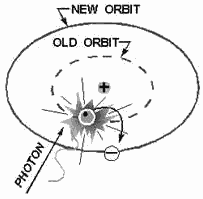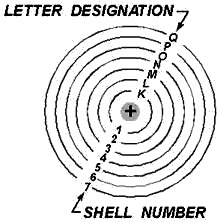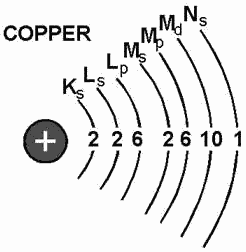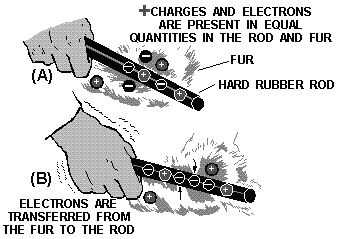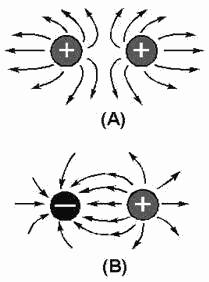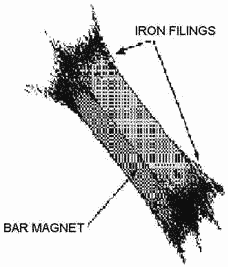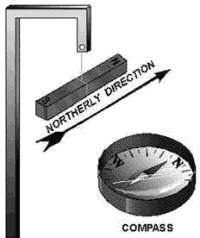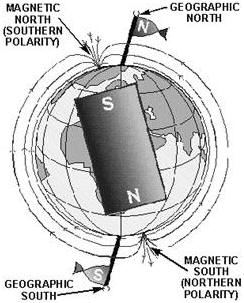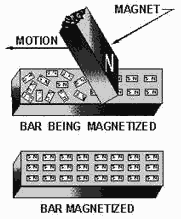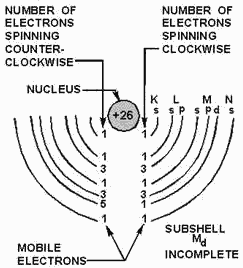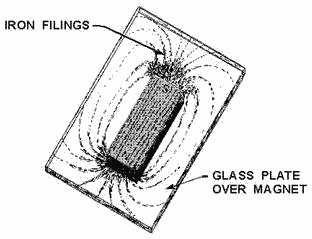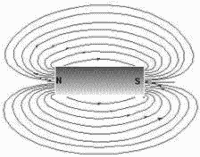Introduction to Matter, Energy, and Direct Current
|
||||||||||||||||||||||||||||||||||||||||||||||||||
CHAPTER 1 | 2 | 3 LEARNING OBJECTIVES Learning objectives are stated at the beginning each chapter. These learning objectives serve as a preview the information you are expected to learn in the chapter. The comprehensive check questions are based on the objectives. By successfully completing the NRTC, you indicate that you have met the objectives and have learned the information. The learning objectives are listed below. Upon completing this chapter, you will be able to: 1. State the meanings and the relationship between matter, element, nucleus, compound, molecule, mixture, atom, electron, proton, neutron, energy, valence, valence shell, and ion. 2. State the meanings and the relationship between kinetic energy, potential energy, photons, electron orbits, energy levels, and shells and subshells. 3. State, in terms valence, the differences between a conductor, an insulator, and a semiconductor, and list some materials which make the best conductors and insulators. 4. State the definition static electricity and explain how static electricity is generated. 5. State the meanings retentivity, reluctance, permeability, ferromagnetism, natural magnet, and artificial magnet as used to describe magnetic materials. 6. State the Weber and domain theories magnetism and list six characteristics magnetic lines force (magnetic flux), including their relation to magnetic induction, shielding, shape, and storage. 7. State, using the water analogy, how a difference potential (a voltage or an electromotive force) can exist. Convert volts to microvolts, to millivolts, and to kilovolts. 8. List six methods for producing a voltage (EMF) and state the operating principles and the uses for each method. 9. State the meanings electron current, random drift, directed drift, and ampere, and indicate the direction that an electric current flows. 10. State the relationship current to voltage and convert amperes to milliamperes and microamperes. 11. State the definitions and the terms and symbols for resistance and conductance, and how the temperature, contents, length and cross-sectional area a conductor affect its resistance and conductance values. 12. List the physical and operating characteristics and the symbols, ratings, and uses for various types resistors; use the color code to identify resistor values. INTRODUCTION The origin the modern technical and electronic Navy stretches back to the beginning naval history, when the first navies were no more than small fleets wooden ships, using wind-filled sails and manned oars. The need for technicians then was restricted to a navigator and semiskilled seamen who could handle the sails. As time passed, larger ships that carried more sail were built. These ships, encouraging exploration and commerce, helped to establish world trade routes. Soon strong navies were needed to guard these sea lanes. Countries established their own navies to protect their citizens, commercial ships, and shipping lanes against pirates and warring nations. With the addition mounted armament, gunners joined the ship's company skilled or semiskilled technicians. The advent the steam engine signaled the rise an energy source more practical than either wind and sails or manpower. With this technological advancement, the need for competent operators and technicians increased. However, the big call for operators and technicians in the U.S. Navy came in the early part the 20th century, when power sources, means communication, modes detection, and armaments moved with amazing rapidity toward involved technical development. Electric motors and generators by then had become the most widely used sources power. Telephone systems were well established on board ship, and radio was being used more and more to relay messages from ship to ship and from ship to shore. Listening devices were employed to detect submarines. Complex optical systems were used to aim large naval rifles. Mines and torpedoes became highly developed, effective weapons, and airplanes joined the Navy team. During the years after World War I, the Navy became more electricity and electronic minded. It was recognized that a better system communications was needed aboard each ship, and between the ships, planes, submarines, and shore installations; and that weaponry advances were needed to keep pace with worldwide developments in that field. This growing technology carried with it the awareness that an equally skilled force technicians was needed for maintenance and service duties. World War II proved that all the expense providing equipment for the fleet and training personnel to handle that equipment paid great dividends. The U. S. Navy had the modern equipment and highly trained personnel needed to defeat the powerful fleets the enemy. Today there is scarcely anyone on board a Navy ship who does not use electrical or electronic equipment. This equipment is needed in systems electric lighting and power, intercommunications, radio, radar, sonar, loran, remote metering, weapon aiming, and certain types mines and torpedoes. The Navy needs trained operators and technicians in this challenging field electronics and electricity. It is to achieve this end that this module, and others like it, are published. MATTER, ENERGY, and ELECTRICITY If there are roots to western science, they no doubt lie under the rubble that was once ancient Greece. With the exception the Greeks, ancient people had little interest in the structure materials. They accepted a solid as being just that a continuous, uninterrupted substance. One Greek school thought believed that if a piece matter, such as copper, were subdivided, it could be done indefinitely and still only that material would be found. Others reasoned that there must be a limit to the number subdivisions that could be made and have the material still retain its original characteristics. They held fast to the idea that there must be a basic particle upon which all substances are built. Recent experiments have revealed that there are, indeed, several basic particles, or building blocks within all substances. The following paragraphs explain how substances are classified as elements and compounds, and are made up molecules and atoms. This, then, will be a learning experience about protons, electrons, valence, energy levels, and the physics electricity. MATTER Matter is defined as anything that occupies space and has weight; that is, the weight and dimensions matter can be measured. Examples matter are air, water, automobiles, clothing, and even our own bodies. Thus, we can say that matter may be found in any one three states: SOLID, LIQUID, and GASEOUS. ELEMENTS and COMPOUNDS An ELEMENT is a substance which cannot be reduced to a simpler substance by chemical means. Examples elements with which you are in everyday contact are iron, gold, silver, copper, and oxygen. There are now over 100 known elements. All the different substances we know about are composed one or more these elements. When two or more elements are chemically combined, the resulting substance is called a COMPOUND. a compound is a chemical combination elements which can be separated by chemical but not by physical means. Examples common compounds are water which consists hydrogen and oxygen, and table salt, which consists sodium and chlorine. a MIXTURE, on the other hand, is a combination elements and compounds, not chemically combined, that can be separated by physical means. Examples mixtures are air, which is made up nitrogen, oxygen, carbon dioxide, and small amounts several rare gases, and sea water, which consists chiefly salt and water. Q1. What is matter, and in what three states is it found? Q2. What is an element? Q3. What is a compound? Q4. What is the difference between a compound and a mixture? MOLECULES A MOLECULE is a chemical combination two or more atoms, (atoms are described in the next paragraph). In a compound the molecule is the smallest particle that has all the characteristics the compound. Consider water, for example. Water is matter, since it occupies space and has weight. Depending on the temperature, it may exist as a liquid (water), a solid (ice), or a gas (steam). Regardless the temperature, it will still have the same composition. If we start with a quantity water, divide this and pour out one half, and continue this process a sufficient number times, we will eventually end up with a quantity water which cannot be further divided without ceasing to be water. This quantity is called a molecule water. If this molecule water divided, instead two parts water, there will be one part oxygen and two parts hydrogen (H 2 O). ATOMS Molecules are made up smaller particles called ATOMS. An atom is the smallest particle an element that retains the characteristics that element. The atoms one element, however, differ from the atoms all other elements. Since there are over 100 known elements, there must be over 100 different atoms, or a different atom for each element. Just as thousands words can be made by combining the proper letters the alphabet, so thousands different materials can be made by chemically combining the proper atoms. Any particle that is a chemical combination two or more atoms is called a molecule. The oxygen molecule consists two atoms oxygen, and the hydrogen molecule consists two atoms hydrogen. Sugar, on the other hand, is a compound composed atoms carbon, hydrogen, and oxygen. These atoms are combined into sugar molecules. Since the sugar molecules can be broken down by chemical means into smaller and simpler units, we cannot have sugar atoms. The atoms each element are made up electrons, protons, and, in most cases, neutrons, which are collectively called subatomic particles. Furthermore, the electrons, protons, and neutrons one element are identical to those any other element. The reason that there are different kinds elements is that the number and the arrangement electrons and protons within the atom are different for the different elements. The electron is considered to be a small negative charge electricity. The proton has a positive charge electricity equal and opposite to the charge the electron. Scientists have measured the mass and size the electron and proton, and they know how much charge each possesses. The electron and proton each have the same quantity charge, although the mass the proton is approximately 1837 times that the electron. In some atoms there exists a neutral particle called a neutron. The neutron has a mass approximately equal to that a proton, but it has no electrical charge. According to a popular theory, the electrons, protons, and neutrons the atoms are thought to be arranged in a manner similar to a miniature solar system. The protons and neutrons form a heavy nucleus with a positive charge, around which the very light electrons revolve.
Figure 1-1. - Structures simple atoms. Figure 1-1 shows one hydrogen and one helium atom. Each has a relatively simple structure. The hydrogen atom has only one proton in the nucleus with one electron rotating about it. The helium atom is a little more complex. It has a nucleus made up two protons and two neutrons, with two electrons rotating about the nucleus. Elements are classified numerically according to the complexity their atoms. The atomic number an atom is determined by the number protons in its nucleus. In a neutral state, an atom contains an equal number protons and electrons. Therefore, an atom hydrogen - which contains one proton and one electron - has an atomic number 1; and helium, with two protons and two electrons, has an atomic number 2. The complexity atomic structure increases with the number protons and electrons. Q5. What is a molecule? Q6. What are the three types subatomic particles, and what are their charges? ENERGY LEVELS Since an electron in an atom has both mass and motion, it contains two types energy. By virtue its motion the electron contains KINETIC ENERGY. Due to its position it also contains POTENTIAL ENERGY. The total energy contained by an electron (kinetic plus potential) is the factor which determines the radius the electron orbit. In order for an electron to remain in this orbit, it must neither Gain nor LOSE energy. It is well known that light is a form energy, but the physical form in which this energy exists is not known.
Figure 1-2. - Excitation by a photon. One accepted theory proposes the existence light as tiny packets energy called PHOTONS. Photons can contain various quantities energy. The amount depends upon the color the light involved. Should a photon sufficient energy collide with an orbital electron, the electron will absorb the photon's energy, as shown in figure 1-2. The electron, which now has a greater than normal amount energy, will jump to a new orbit farther from the nucleus. The first new orbit to which the electron can jump has a radius four times as large as the radius the original orbit. Had the electron received a greater amount energy, the next possible orbit to which it could jump would have a radius nine times the original. Thus, each orbit may be considered to represent one a large number energy levels that the electron may attain. It must be emphasized that the electron cannot jump to just any orbit. The electron will remain in its lowest orbit until a sufficient amount energy is available, at which time the electron will accept the energy and jump to one a series permissible orbits. An electron cannot exist in the space between energy levels. This indicates that the electron will not accept a photon energy unless it contains enough energy to elevate itself to one the higher energy levels. Heat energy and collisions with other particles can also cause the electron to jump orbits. Once the electron has been elevated to an energy level higher than the lowest possible energy level, the atom is said to be in an excited state. The electron will not remain in this excited condition for more than a fraction a second before it will radiate the excess energy and return to a lower energy orbit. To illustrate this principle, assume that a normal electron has just received a photon energy sufficient to raise it from the first to the third energy level. In a short period time the electron may jump back to the first level emitting a new photon identical to the one it received. A second alternative would be for the electron to return to the lower level in two jumps; from the third to the second, and then from the second to the first. In this case the electron would emit two photons, one for each jump. Each these photons would have less energy than the original photon which excited the electron. This principle is used in the fluorescent light where ultraviolet light photons, which are not visible to the human eye, bombard a phosphor coating on the inside a glass tube. The phosphor electrons, in returning to their normal orbits, emit photons light that are visible. By using the proper chemicals for the phosphor coating, any color light may be obtained, including white. This same principle is also used in lighting up the screen a television picture tube. The basic principles just developed apply equally well to the atoms more complex elements. In atoms containing two or more electrons, the electrons interact with each other and the exact path any one electron is very difficult to predict. However, each electron lies in a specific energy band and the orbits will be considered as an average the electron's position. Q7. What is energy motion called? Q8. How is invisible light changed to visible light in a fluorescent light? SHELLS AND SUBSHELLS The difference between the atoms, insofar as their chemical activity and stability are concerned, is dependent upon the number and position the electrons included within the atom. How are these electrons positioned within the atom? In general, the electrons reside in groups orbits called shells. These shells are elliptically shaped and are assumed to be located at fixed intervals. Thus, the shells are arranged in steps that correspond to fixed energy levels. The shells, and the number electrons required to fill them, may be predicted by the employment Pauli's exclusion principle. Simply stated, this principle specifies that each shell will contain a maximum 2n2electrons, where n corresponds to the shell number starting with the one closest to the nucleus. By this principle, the second shell, for example, would contain 2(2) 2 or 8 electrons when full.
Figure 1-3. - Shell designation.
Figure 1-4. - Copper atom. In addition to being numbered, the shells are also given letter designations, as pictured in figure 1-3. Starting with the shell closest to the nucleus and progressing outward, the shells are labeled K, L, M, N, O, P, and Q, respectively. The shells are considered to be full, or complete, when they contain the following quantities electrons: two in the K shell, eight in the L shell, 18 in the M shell, and so on, in accordance with the exclusion principle. Each these shells is a major shell and can be divided into subshells, which there are four, labeled s, p, d, and f. Like the major shells, the subshells are also limited as to the number electrons which they can contain. Thus, the "s" subshell is complete when it contains two electrons, the "p" subshell when it contains 10, and the "f" subshell when it contains 14 electrons. Inasmuch as the K shell can contain no more than two electrons, it must have only one subshell, the s subshell. The M shell is composed three subshells: s, p, and d. If the electrons in the s, p, and d subshells are added, their total is found to be 18, the exact number required to fill the M shell. Notice the electron configuration for copper illustrated in figure 1-4. The copper atom contains 29 electrons, which completely fill the first three shells and subshells, leaving one electron in the "s" subshell the N shell. VALENCE The number electrons in the outermost shell determines the valence an atom. For this reason, the outer shell an atom is called the VALENCE SHELL; and the electrons contained in this shell are called VALENCE ELECTRONS. The valence an atom determines its ability to gain or lose an electron, which in turn determines the chemical and electrical properties the atom. An atom that is lacking only one or two electrons from its outer shell will easily gain electrons to complete its shell, but a large amount energy is required to free any its electrons. An atom having a relatively small number electrons in its outer shell in comparison to the number electrons required to fill the shell will easily lose these valence electrons. The valence shell always refers to the outermost shell. Q9. What determines the valence an atom? IONIZATION When the atom loses electrons or gains electrons in this process electron exchange, it is said to be IONIZED. For ionization to take place, there must be a transfer energy which results in a change in the internal energy the atom. An atom having more than its normal amount electrons acquires a negative charge, and is called a Negative ION. The atom that gives up some its normal electrons is left with less negative charges than positive charges and is called a Positive ION. Thus, ionization is the process by which an atom loses or gains electrons. Q1O. What is an ion? Conductors, Semiconductors, and Insulators In this study electricity and electronics, the association matter and electricity is important. Since every electronic device is constructed parts made from ordinary matter, the effects electricity on matter must be well understood. As a means accomplishing this, all elements which matter is made may be placed into one three categories: Conductors, Semiconductors, and Insulators, depending on their ability to conduct an electric current. Conductors are elements which conduct electricity very readily, Insulators have an extremely high resistance to the flow electricity. All matter between these two extremes may be called Semiconductors. The electron theory states that all matter is composed atoms and the atoms are composed smaller particles called protons, electrons, and neutrons. The electrons orbit the nucleus which contains the protons and neutrons. It is the valence electrons that we are most concerned with in electricity. These are the electrons which are easiest to break loose from their parent atom. Normally, conductors have three or less valence electrons; insulators have five or more valence electrons; and semiconductors usually have four valence electrons. The electrical conductivity matter is dependent upon the atomic structure the material from which the conductor is made. In any solid material, such as copper, the atoms which make up the molecular structure are bound firmly together. At room temperature, copper will contain a considerable amount heat energy. Since heat energy is one method removing electrons from their orbits, copper will contain many free electrons that can move from atom to atom. When not under the influence an external force, these electrons move in a haphazard manner within the conductor. This movement is equal in all directions so that electrons are not lost or gained by any part the conductor. When controlled by an external force, the electrons move generally in the same direction. The effect this movement is felt almost instantly from one end the conductor to the other. This electron movement is called an ELECTRIC CURRENT. Some metals are better conductors electricity than others. Silver, copper, gold, and aluminum are materials with many free electrons and make good conductors. Silver is the best conductor, followed by copper, gold, and aluminum. Copper is used more ten than silver because cost. Aluminum is used where weight is a major consideration, such as in high-tension power lines, with long spans between supports. Gold is used where oxidation or corrosion is a consideration and a good conductivity is required. The ability a conductor to handle current also depends upon its physical dimensions. Conductors are usually found in the form wire, but may be in the form bars, tubes, or sheets. Nonconductors have few free electrons. These materials are called Insulators. Some examples these materials are rubber, plastic, enamel, glass, dry wood, and mica. Just as there is no perfect conductor, neither is there a perfect insulator. Some materials are neither good conductors nor good insulators, since their electrical characteristics fall between those conductors and insulators. These in-between materials are classified as Semiconductors. Germanium and silicon are two common semiconductors used in solid-state devices. Q11. What determines whether a substance is a conductor or an insulator? ELECTROSTATICS Electrostatics (electricity at rest) is a subject with which most persons entering the field electricity and electronics are somewhat familiar. For example, the way a person's hair stands on end after a vigorous rubbing is an effect electrostatics. While pursuing the study electrostatics, you will gain a better understanding this common occurrence. even greater significance, the study electrostatics will provide you with the opportunity to gain important background knowledge and to develop concepts which are essential to the understanding electricity and electronics. Interest in the subject static electricity can be traced back to the Greeks. Thales Miletus, a Greek philosopher and mathematician, discovered that when an amber rod is rubbed with fur, the rod has the amazing characteristic attracting some very light objects such as bits paper and shavings wood. About 1600, William Gilbert, an English scientist, made a study other substances which had been found to possess qualities attraction similar to amber. Among these were glass, when rubbed with silk, and ebonite, when rubbed with fur. Gilbert classified all the substances which possessed properties similar to those amber as electrics, a word Greek origin meaning amber. Because Gilbert's work with electrics, a substance such as amber or glass when given a vigorous rubbing was recognized as being ELECTRIFIED, or CHARGED with electricity. In the year 1733, Charles Dufay, a French scientist, made an important discovery about electrification. He found that when a glass was rubbed with fur, both the glass rod and the fur became electrified. This realization came when he systematically placed the glass rod and the fur near other electrified substances and found that certain substances which were attracted to the glass rod were repelled by the fur, and vice versa. From experiments such as this, he concluded that there must be two exactly opposite kinds electricity. Benjamin Franklin, American statesman, inventor, and philosopher, is credited with first using the terms Positive and Negative to describe the two opposite kinds electricity. The charge produced on a glass rod when it is rubbed with silk, Franklin labeled positive. He attached the term negative to the charge produced on the silk. Those bodies which were not electrified or charged, he called NEUTRAL. STATIC ELECTRICITY In a natural, or neutral state, each atom in a body matter will have the proper number electrons in orbit around it. Consequently, the whole body matter composed the neutral atoms will also be electrically neutral. In this state, it is said to have a "zero charge." Electrons will neither leave nor enter the neutrally charged body should it come in contact with other neutral bodies. If, however, any number electrons are removed from the atoms a body matter, there will remain more protons than electrons and the whole body matter will become ELECTRICALLY Positive. Should the positively charged body come in contact with another body having a normal charge, or having a Negative (too many electrons) charge, an electric current will flow between them. Electrons will leave the more negative body and enter the positive body. This electron flow will continue until both bodies have equal charges. When two bodies matter have unequal charges and are near one another, an electric force is exerted between them because their unequal charges. However, since they are not in contact, their charges cannot equalize. The existence such an electric force, where current cannot flow, is referred to as static electricity. ("Static" in this instance means "not moving.") It is also referred to as an electrostatic force.
Figure 1-5. - Producing static electricity by friction. One the easiest ways to create a static charge is by friction. When two pieces matter are rubbed together, electrons can be "wiped f" one material onto the other. If the materials used are good conductors, it is quite difficult to obtain a detectable charge on either, since equalizing currents can flow easily between the conducting materials. These currents equalize the charges almost as fast as they are created. a static charge is more easily created between nonconducting materials. When a hard rubber rod is rubbed with fur, the rod will accumulate electrons given up by the fur, as shown in figure 1-5. Since both materials are poor conductors, very little equalizing current can flow, and an electrostatic charge builds up. When the charge becomes great enough, current will flow regardless the poor conductivity the materials. These currents will cause visible sparks and produce a crackling sound. Q12. How is a negative charge created in a neutral body? Q13. How are static charges created? NATURE CHARGES When in a natural, or neutral state, an atom has an equal number electrons and protons. Because this balance, the net negative charge the electrons in orbit is exactly balanced by the net positive charge the protons in the nucleus, making the atom electrically neutral. An atom becomes a positive ion whenever it loses an electron, and has an overall positive charge. Conversely, whenever an atom acquires an extra electron, it becomes a negative ion and has a negative charge. Due to normal molecular activity, there are always ions present in any material. If the number positive ions and negative ions is equal, the material is electrically neutral. When the number positive ions exceeds the number negative ions, the material is positively charged. The material is negatively charged whenever the negative ions outnumber the positive ions. Since ions are actually atoms without their normal number electrons, it is the excess or the lack electrons in a substance that determines its charge. In most solids, the transfer charges is by movement electrons rather than ions. The transfer charges by ions will become more significant when we consider electrical activity in liquids and gases. At this time, we will discuss electrical behavior in terms electron movement. Q14. What is the electrical charge an atom which contains 8 protons and 11 electrons? CHARGED BODIES
Figure 1-6. - Reaction between charged bodies. One the fundamental laws electricity is that LIKE CHARGES REPEL EACH OTHER and UNLIKE CHARGES ATTRACT EACH OTHER. a positive charge and negative charge, being unlike, tend to move toward each other. In the atom, the negative electrons are drawn toward the positive protons in the nucleus. This attractive force is balanced by the electron's centrifugal force caused by its rotation about the nucleus. As a result, the electrons remain in orbit and are not drawn into the nucleus. Electrons repel each other because their like negative charges, and protons repel each other because their like positive charges. The law charged bodies may be demonstrated by a simple experiment. Two pith (paper pulp) balls are suspended near one another by threads, as shown in figure 1-6. If a hard rubber rod is rubbed with fur to give it a negative charge and is then held against the right- hand ball in part (A), the rod will give f a negative charge to the ball. The right-hand ball will have a negative charge with respect to the left-hand ball. When released, the two balls will be drawn together, as shown in figure 1-6(A). They will touch and remain in contact until the left-hand ball gains a portion the negative charge the right-hand ball, at which time they will swing apart as shown in figure 1-6(C). If a positive or a negative charge is placed on both balls (fig. 1-6(B)), the balls will repel each other. Coulomb's Law Charges The relationship between attracting or repelling charged bodies was first discovered and written about by a French scientist named Charles A. Coulomb. Coulomb's Law states that CHARGED BODIES ATTRACT OR REPEL EACH OTHER WITH a forCE THAT Is DirectLY PROPORTIONAL to The Product THEIR INDIVIDUAL CHARGES, and Is INVERSELY PROPORTIONAL to The SQUARE The DIsTANCE BETWEEN THEM. The amount attracting or repelling force which acts between two electrically charged bodies in free space depends on two things - (1) their charges and (2) the distance between them. Electric Fields The space between and around charged bodies in which their influence is felt is called an ELECTRIC FIELD forCE. It can exist in air, glass, paper, or a vacuum. ELECTROSTATIC FIELDS and Dielectric FIELDS are other names used to refer to this region force. Fields force spread out in the space surrounding their point origin and, in general, DIMINISH IN PROPORTION to the SQUARE of the DISTANCE FROM THEIR SOURCE.
Figure 1-7. - Electrostatic lines force. The field about a charged body is generally represented by lines which are referred to as ELECTROSTATIC Lines FORCE. These lines are imaginary and are used merely to represent the direction and strength the field. To avoid confusion, the lines force exerted by a positive charge are always shown leaving the charge, and for a negative charge they are shown entering. Figure 1-7 illustrates the use lines to represent the field about charged bodies. Figure 1-7(A) represents the repulsion like-charged bodies and their associated fields. Part (B) represents the attraction unlike-charged bodies and their associated fields. Q15. What is the relationship between charged bodies? Q16. What is an electrostatic field? Q17. In what direction are electrostatic lines force drawn? MAGNETISM In order to properly understand the principles electricity, it is necessary to study magnetism and the effects magnetism on electrical equipment. Magnetism and electricity are so closely related that the study either subject would be incomplete without at least a basic knowledge the other. Much today's modern electrical and electronic equipment could not function without magnetism. Modern computers, tape recorders, and video reproduction equipment use magnetized tape. High-fidelity speakers use magnets to convert amplifier outputs into audible sound. Electrical motors use magnets to convert electrical energy into mechanical motion; generators use magnets to convert mechanical motion into electrical energy. Q18. What are some examples electrical equipment which use magnetism? MAGNETIC MATERIALS Magnetism is generally defined as that property a material which enables it to attract pieces iron. a material possessing this property is known as a MAGNET. The word originated with the ancient Greeks, who found stones possessing this characteristic. Materials that are attracted by a magnet, such as iron, steel, nickel, and cobalt, have the ability to become magnetized. These are called magnetic materials. Materials, such as paper, wood, glass, or tin, which are not attracted by magnets, are considered nonmagnetic. Nonmagnetic materials are not able to become magnetized. Q19. What are magnetic materials? FERROMAGNETIC MATERIALS The most important group materials connected with electricity and electronics are the ferromagnetic materials. Ferromagnetic materials are those which are relatively easy to magnetize, such as iron, steel, cobalt, and the alloys Alnico and Permalloy. (An alloy is made from combining two or more elements, one which must be a metal). These new alloys can be very strongly magnetized, and are capable obtaining a magnetic strength great enough to lift 500 times their own weight. Natural Magnets Magnetic stones such as those found by the ancient Greeks are considered to be NATURAL MAGNETS. These stones had the ability to attract small pieces iron in a manner similar to the magnets which are common today. However, the magnetic properties attributed to the stones were products nature and not the result the efforts man. The Greeks called these substances magnetite. The Chinese are said to have been aware some the effects magnetism as early as 2600 B.C. They observed that stones similar to magnetite, when freely suspended, had a tendency to assume a nearly north and south direction. Because the directional quality these stones, they were later referred to as lodestones or leading stones. Natural magnets, which presently can be found in the United States, Norway, and Sweden, no longer have any practical use, for it is now possible to easily produce more powerful magnets. Q20. What characteristics do all ferromagnetic materials have in common? ARTIFICIAL MAGNETS Magnets produced from magnetic materials are called ARTIFICIAL MAGNETS. They can be made in a variety shapes and sizes and are used extensively in electrical apparatus. Artificial magnets are generally made from special iron or steel alloys which are usually magnetized electrically. The material to be magnetized is inserted into a coil insulated wire and a heavy flow electrons is passed through the wire. Magnets can also be produced by stroking a magnetic material with magnetite or with another artificial magnet. The forces causing magnetization are represented by magnetic lines force, very similar in nature to electrostatic lines force. Artificial magnets are usually classified as PERMANENT or TEMPORARY, depending on their ability to retain their magnetic properties after the magnetizing force has been removed. Magnets made from substances, such as hardened steel and certain alloys which retain a great deal their magnetism, are called PERMANENT MAGNETS. These materials are relatively difficult to magnetize because the opposition refered to the magnetic lines force as the lines force try to distribute themselves throughout the material. The opposition that a material refers to the magnetic lines force is called RELUCTANCE. All permanent magnets are produced from materials having a high reluctance. A material with a low reluctance, such as st iron or annealed silicon steel, is relatively easy to magnetize but will retain only a small part its magnetism once the magnetizing force is removed. Materials this type that easily lose most their magnetic strength are called TEMPORARY MAGNETS. The amount magnetism which remains in a temporary magnet is referred to as its RESIDUAL MAGNETISM. The ability a material to retain an amount residual magnetism is called the RETENTIVITY the material. The difference between a permanent and a temporary magnet has been indicated in terms RELUCTANCE, a permanent magnet having a high reluctance and a temporary magnet having a low reluctance. Magnets are also described in terms the PERMEABILITY their materials, or the ease with which magnetic lines force distribute themselves throughout the material. a permanent magnet, which is produced from a material with a high reluctance, has a low permeability. a temporary magnet, produced from a material with a low reluctance, would have a high permeability. Q21. What type magnetic material should be used to make a temporary magnet? Q22. What is retentivity? MAGNETIC POLES
Figure 1-8. - Iron filings cling to the poles of a magnet.
Figure 1-9. - a bar magnet acts as a compass.
Figure 1-10. - The earth is a magnet.
Figure 1-11. - Weber's molecular theory magnetism. The magnetic force surrounding a magnet is not uniform. There exists a great concentration force at each end the magnet and a very weak force at the center. Pro this fact can be obtained by dipping a magnet into iron filings (fig. 1-8). It is found that many filings will cling to the ends the magnet while very few adhere to the center. The two ends, which are the regions concentrated lines force, are called the POLES the magnet. Magnets have two magnetic poles and both poles have equal magnetic strength. LAW of MAGNETIC POLES If a bar magnet is suspended freely on a string, as shown in figure 1-9, it will align itself in a north and south direction. When this experiment is repeated, it is found that the same pole the magnet will always swing toward the north magnetic pole the earth. Therefore, it is called the north-seeking pole or simply the NORTH POLE. The other pole the magnet is the south-seeking pole or the SOUTH POLE. A practical use the directional characteristic the magnet is the compass, a device in which a freely rotating magnetized needle indicator points toward the North Pole. The realization that the poles a suspended magnet always move to a definite position gives an indication that the opposite poles a magnet have opposite magnetic polarity. The law previously stated regarding the attraction and repulsion charged bodies may also be applied to magnetism if the pole is considered as a charge. The north pole a magnet will always be attracted to the south pole another magnet and will show a repulsion to a north pole. The law for magnetic poles is: Like poles repel, unlike poles attract. Q23. How does the law magnetic poles relate to the law electric charges? The Earth's Magnetic Poles The fact that a compass needle always aligns itself in a particular direction, regardless its location on earth, indicates that the earth is a huge natural magnet. The distribution the magnetic force about the earth is the same as that which might be produced by a giant bar magnet running through the center the earth (fig. 1-10). The magnetic axis the earth is located about 15° from its geographical axis thereby locating the magnetic poles some distance from the geographical poles. The ability the north pole the compass needle to point toward the north geographical pole is due to the presence the magnetic pole nearby. This magnetic pole is named the magnetic North Pole. However, in actuality, it must have the polarity a south magnetic pole since it attracts the north pole a compass needle. The reason for this conflict in terminology can be traced to the early users the compass. Knowing little about magnetic effects, they called the end the compass needle that pointed towards the north geographical pole, the north pole a compass. With our present knowledge magnetism, we know the north pole a compass needle (a small bar magnet) can be attracted only by an unlike magnetic pole, that is, a pole south magnetic polarity. Q24. a compass is located at the geographical North Pole. In which direction would its needle pointy THEORIES MAGNETISM WEBER'S THEORY A popular theory magnetism considers the molecular alignment the material. This is known as Weber's theory. This theory assumes that all magnetic substances are composed tiny molecular magnets. Any unmagnetized material has the magnetic forces its molecular magnets neutralized by adjacent molecular magnets, thereby eliminating any magnetic effect. a magnetized material will have most its molecular magnets lined up so that the north pole each molecule points in one direction, and the south pole faces the opposite direction. a material with its molecules thus aligned will then have one effective north pole, and one effective south pole. An illustration Weber's Theory is shown in figure 1-11, where a steel bar is magnetized by stroking. When a steel bar is stroked several times in the same direction by a magnet, the magnetic force from the north pole the magnet causes the molecules to align themselves. Q25. Using Weber's molecular theory magnetism, describe the polarity the magnetic poles produced by stroking a magnetic material from right to left with the south pole a magnet. DOMAIN THEORY A more modern theory magnetism is based on the electron spin principle. From the study atomic structure it is known that all matter is composed vast quantities atoms, each atom containing one or more orbital electrons. The electrons are considered to orbit in various shells and subshells depending upon their distance from the nucleus. The structure the atom has previously been compared to the solar system, wherein the electrons orbiting the nucleus correspond to the planets orbiting the sun. Along with its orbital motion about the sun, each planet also revolves on its axis. It is believed that the electron also revolves on its axis as it orbits the nucleus an atom. It has been experimentally proven that an electron has a magnetic field about it along with an electric field. The effectiveness the magnetic field an atom is determined by the number electrons spinning in each direction. If an atom has equal numbers electrons spinning in opposite directions, the magnetic fields surrounding the electrons cancel one another, and the atom is unmagnetized. However, if more electrons spin in one direction than another, the atom is magnetized. An atom with an atomic number 26, such as iron, has 26 protons in the nucleus and 26 revolving electrons orbiting its nucleus.
Figure 1-12. - Iron atom.
Figure 1-13. - Pattern formed by iron filings.
Figure 1-14. - Bar magnet showing lines of force. If 13 electrons are spinning in a clockwise direction and 13 electrons are spinning in a counterclockwise direction, the opposing magnetic fields will be neutralized. When more than 13 electrons spin in either direction, the atom is magnetized. An example a magnetized atom iron is shown in figure 1-12. Q26. What is the difference between the domain theory and Weber‘s theory magnetism? MAGNETIC FIELDS The space surrounding a magnet where magnetic forces act is known as the magnetic field. A pattern this directional force can be obtained by performing an experiment with iron filings. a piece glass is placed over a bar magnet and the iron filings are then sprinkled on the surface the glass. The magnetizing force the magnet will be felt through the glass and each iron filing becomes a temporary magnet. If the glass is now tapped gently, the iron particles will align themselves with the magnetic field surrounding the magnet just as the compass needle did previously. The filings form a definite pattern, which is a visible representation the forces comprising the magnetic field. Examination the arrangements iron filings in figure 1-13 will indicate that the magnetic field is very strong at the poles and weakens as the distance from the poles increases. It is also apparent that the magnetic field extends from one pole to the other, constituting a loop about the magnet. Q27. Refer to figure 1-13. For what purpose would you sprinkle iron filings on the glass plate? Q28. Refer to figure 1-13. What pattern would be formed if sawdust was sprinkled on the glass instead iron filings? Lines of FORCE To further describe and work with magnet phenomena, lines are used to represent the force existing in the area surrounding a magnet (refer to fig. 1-14). These lines, called Magnetic Lines FORCE, do not actually exist but are imaginary lines used to illustrate and describe the pattern the magnetic field. The magnetic lines force are assumed to emanate from the north pole a magnet, pass through surrounding space, and enter the south pole. The lines force then travel inside the magnet from the south pole to the north pole, thus completing a closed loop.
|
||||||||||||||||||||||||||||||||||||||||||||||||||

